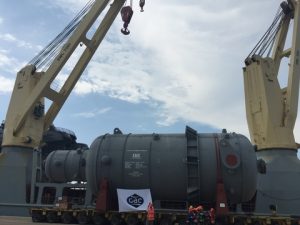
GAC safely coordinated the move of two water cooling reactors from Yokohama, Japan, to the Port of Coatzacoalcos in Mexico for Pemex.
Giant pair safely completed journey from Japan to Mexico
Houston, 16 November 2015 – Severe weather did not daunt GAC’s project logistics experts when they were appointed to coordinate the delivery of a pair of water-cooled reactors safely to the Pemex petrochemical complex in Morelos, Mexico.
The reactors, each nearly 23 metres long and weighing in at 860 tonnes, had been shipped to the port of Coatzacoalcos from Yokohama, Japan. But it was the last leg of their voyage – about 5 miles by road to the refinery where they play an essential part in the refining process – that proved the most challenging.
Heavy rain and flash floods meant they were delayed by three weeks in setting off for the refinery. Not only did the rain make for less than perfect conditions for the road transportation, it also disrupted work to widen the roads.
Yalonda Henderson, National Freight and Project Manager for GAC North America – Logistics, says the arrival of the vessel was scheduled with the road works in mind.
“Despite this unforeseen delay, it was completed without any loss time accidents, ” she says.
Jorge Pasaret, Logistics Services General Manager, of Pemex says: “We knew GAC could handle the transport, and we were confident that they would rise to any challenge that the weather and road conditions would present for this project. The way they handled the task both justified that confidence and proved that GAC was the best choice for our project.”
The two new water-cooled reactors are now in place at the Morelos complex, where they will replace the four existing oil-cooled reactors to increase the plant’s annual capacity from 280, 000 tonnes/year to 360, 000 tonnes/year of ethylene oxide. Operations are set to start in 2018.





